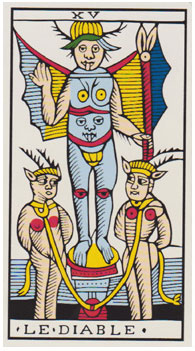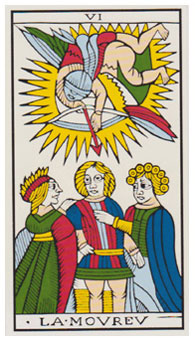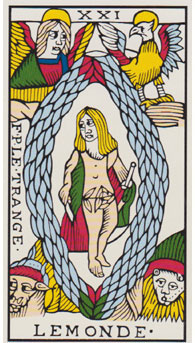|
 The French artist and card maker Jean-Claude Flornoy, published back in 2007 his restoration of the Parisian card maker
Jean Noblet's Marseille-pattern tarot from 1650 (reviewed in TPC, vol. 36 #1). Now comes, from Flornoy's studio,
another restoration of an early French tarot: Jean Dodal's Marseille pattern, which Flornoy dates as having been
printed in 1701. Dodal was a registered master card maker in Lyon from 1701-1715.
The French artist and card maker Jean-Claude Flornoy, published back in 2007 his restoration of the Parisian card maker
Jean Noblet's Marseille-pattern tarot from 1650 (reviewed in TPC, vol. 36 #1). Now comes, from Flornoy's studio,
another restoration of an early French tarot: Jean Dodal's Marseille pattern, which Flornoy dates as having been
printed in 1701. Dodal was a registered master card maker in Lyon from 1701-1715.
There appears to be an increasing interest for the early Marseille tarot packs; an interest Flornoy's restoration of
Noblet's Marseille deck possibly has stimulated. Jean-Michel David (Association for Tarot Studies) has furthered
this interest by offering an essentially free self-study tarot course, based upon the Noblet pack, in 30 weekly
lessons (about 300 A4-size pages in total), which are distributed as pdf-files to the students
(see:
www.fourhares.com
.) In the profusely illustrated lessons David guides the students through the intricacies
of the 78 cards, explaining every tiny symbol in detail.
Jean-Claude Flornoy's Dodal restoration is based upon the only two surviving decks from Dodal's workshop; one kept
in Bibliotèque Nationale in Paris, another in a British Museum. A closer study convinced him, that they both are
printed from the same blocks. The declared purpose of the restoration was to get back as close to the original deck
as possible by, for example, unearthing details only vaguely visible in the originals.
 The cards are large, 132x72 mm, and are printed on quality playing card board (in Bibliotéque Nationale's catalogue
`Tarot, Jeu et Magie' (1984) the size of the original cards is given as 123x66 mm). The colours are bright, maybe
too bright. I do not believe that a tarot pack in 1701 had a strong radiation of colours like that; modern synthetic
printing ink can not justly render stencil colours as they were 300 years ago. Looking away from the colours, it
is the line art that attracts us. Flornoy has meticulously and excellently rendered all details as he saw them
in the two surviving decks. There are many details, such as eye expressions, hand gestures, clothes, implements carried
by the characters. One detail that immediately struck me is, that the Dodal tarot entirely lacks the implicit
erotic tone we saw in Floroy's Noblet restoration. What had happened during the 50 years between the Noblet and Dodal?
Or was it maybe more than 50 years?
The cards are large, 132x72 mm, and are printed on quality playing card board (in Bibliotéque Nationale's catalogue
`Tarot, Jeu et Magie' (1984) the size of the original cards is given as 123x66 mm). The colours are bright, maybe
too bright. I do not believe that a tarot pack in 1701 had a strong radiation of colours like that; modern synthetic
printing ink can not justly render stencil colours as they were 300 years ago. Looking away from the colours, it
is the line art that attracts us. Flornoy has meticulously and excellently rendered all details as he saw them
in the two surviving decks. There are many details, such as eye expressions, hand gestures, clothes, implements carried
by the characters. One detail that immediately struck me is, that the Dodal tarot entirely lacks the implicit
erotic tone we saw in Floroy's Noblet restoration. What had happened during the 50 years between the Noblet and Dodal?
Or was it maybe more than 50 years?
Several of the cards have the inscription `F.P.LE-TRANCE' (fait pour l'etranger) or `made for export' which I find
to be interesting information, but Flornoy doesn't comment on this.
In the small booklet accompanying the deck, Flornoy ascribes the line art to a skilled wood engraver, Jacques Mermé,
a master member of the `Compagnons'. The word is not translated in the English text, but explained as `medieval
fraternities'. Who they really were is not precisely explained, but my guess is that the `Compagnons' might be a
common name for early (trade) guilds like the masons, established to offer mutual help to the other members, to
secure professionalism within the trade, to advance training of apprentices etc., but also to act as keepers of the
trade's traditions and secrets.
 In the playing card trade we have, as Flornoy rightly states, to distinguish between the engraver and the card maker.
The first being the artist, who provides the basic printing blocks, the second is the practical craftsman, who takes
care of transferring the engraver's art on to the paper and all that has to do with cutting, packing etc. and not
to forget distribution and sale.
In the playing card trade we have, as Flornoy rightly states, to distinguish between the engraver and the card maker.
The first being the artist, who provides the basic printing blocks, the second is the practical craftsman, who takes
care of transferring the engraver's art on to the paper and all that has to do with cutting, packing etc. and not
to forget distribution and sale.
In Flornoy's perspective, Dodal's tarot is the last one to survive from a long tradition. All later tarot decks,
including other Marseilles pattern decks, are inferior, redrawings, or whatever. Why so? To explain this, Flornoy
states, that the French authorities, for taxation control reasons, initiated a veritable autodafé in the year of
1700, burning all playing card print blocks, forcing new ones to be engraved and thus become subject to taxation. I have,
admittedly, never heard that story before and Flornoy doesn't give any sources. I do not believe it, since it would
have caused a stop of the entire playing card production in France or at least would have heavily reduced it for a very
long period. There were many card makers spread around the country, but not that many competent woodblock carvers,
and it takes time to engrave new woodcut plates for 78 detailed prints. Jacques Mermé, who died in 1709 was, as
I read in Flornoy's short text, apparently the only surviving master engraver, who still was able to incorporate
the ancient symbolism, inherited over centuries, into the tarot imagery. Mermé should have taught this symbolism to
his son, Claude, but he died, when the son was only 18 years of age and still an apprentice in the trade.
If Flornoy's report about the burning of the print blocks can not be confirmed, the date of 1701 is also doubtful.
Mermé died not until 1709 and could have engraved the blocks up to that date. That Dodal was established as a
card maker in 1701 doesn't necessarily mean, that he was a maker of tarot decks from the very beginning. Ordinary
playing cards were also in demand.
 What are those symbols then? Flornoy gives examples in short texts regarding the Tower, the Star, the Devil, and the
Sun but says also, that essentially ... we do not understand this imagery directly because it is not intended for
our intellect, but rather for our unconscious... Any possible symbolism related to the court- and number cards is not
mentioned. The genuine tarot symbolism disappeared after Jean Dodal. That is Jean-Claude Flornoy's opinion, and it
is, of course, his right to be of that opinion.
What are those symbols then? Flornoy gives examples in short texts regarding the Tower, the Star, the Devil, and the
Sun but says also, that essentially ... we do not understand this imagery directly because it is not intended for
our intellect, but rather for our unconscious... Any possible symbolism related to the court- and number cards is not
mentioned. The genuine tarot symbolism disappeared after Jean Dodal. That is Jean-Claude Flornoy's opinion, and it
is, of course, his right to be of that opinion.
I prefer to see Flornoy's Dodal tarot restoration as a very welcome tarot pack of historic interest. If this was
his sole intention and it ended here, I would have found it satisfying. What I, however, do not like is Flornoy's
self-assured but only vaguely argumented complete rejection of all later tarot packs, all work done by the French
esoterists of the 19th century and by The Order of the Golden Dawn and, particularly, his hefty attack on Paul
Marteaux's Grimaud tarot which, after all, is the Marseilles pattern most tarotists are familiar with. At the
same time I notice, that Flornoy attemps to approach the same modern tarot card readers, he essentially rejects,
by adapting the original back pattern, which clearly showed what was up and down on the card, to allow the use of
`reversal cards' in card readings. Additionally he uses four pages in the booklet, which could have been used for
further explanation of the symbolism, for a sort of - well, shall I call them `affirmations' or `bonmots' like:
`do what the images do, not what they say'.
|